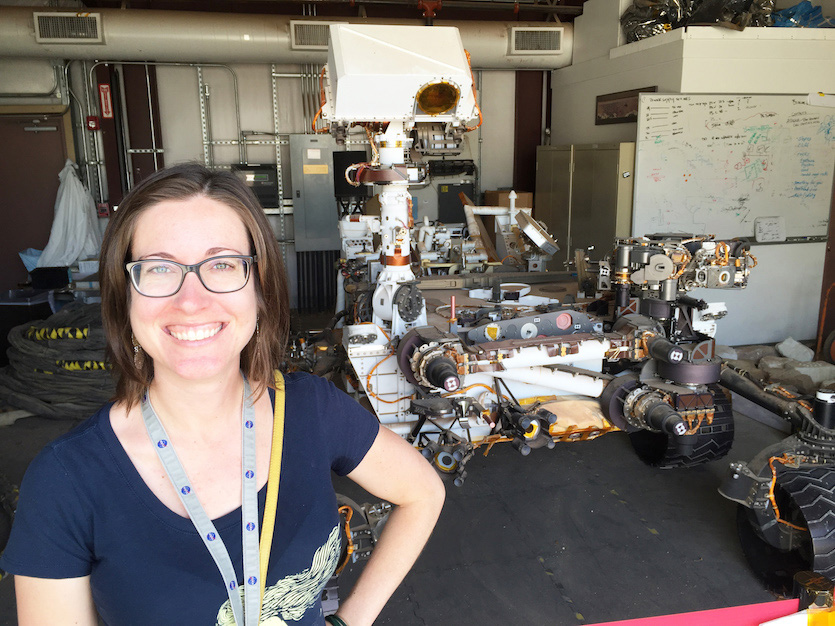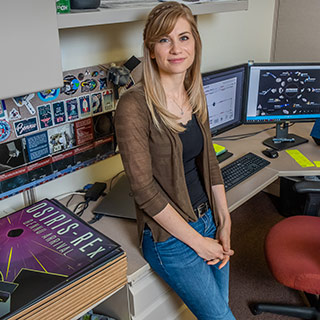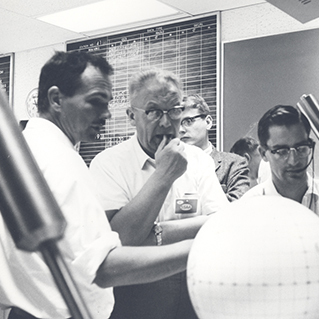People
Katie McKissick
Former Science Writer
Jet Propulsion Laboratory

Editor's Note: Katie left JPL in 2016. She is still communicating science.
Where are you from?
I'm from Reno, NV, otherwise known as the "biggest little city in the world." People tend to think it's near Las Vegas at the southern end of the state, but it's actually about 400 miles away in the foothills of the Sierra Nevada Mountains. I spent summer days swimming in the icy waters of Lake Tahoe and winters sledding, skiing and snowboarding in the mountains.
Describe the first time you made a personal connection with outer space.
I always loved looking at the night sky and spotting constellations I recognized, but I distinctly remember a time when I got a really good glimpse of the starry sky with little light pollution. I was lying on a dock at Lake Tahoe; the lake providing a buffer from the few lights of nearby lake houses. It was by far the most stars I had ever seen, and I could barely believe how many there were. I still have never been anywhere so dark that I could see the haze of the Milky Way, but that's on my to-do list.
How did you end up working in the space program?
I got here in a very roundabout way.
Starting in high school, I was really interested in science, but never felt drawn to any one field in particular. I found them all so fascinating that I couldn't bring myself to choose. In college I delved into biology and chemistry, but I still didn't know what I would do with my degree. In the end I thought being a science teacher would be a good fit for me and would allow me to give back to my community, but I planned to return to graduate school eventually to further study science. During my brief teaching career, I realized that explaining science to others, rather than doing the science itself, was what truly interested me. After that, I decided I wanted to be a science writer.
Start doing what you want to do and see where it leads.
With no science writing experience, I started my own science blog while I worked at an unrelated day job to pay the bills. For years I wrote and published science articles, honing my writing skills and growing an audience. It was this experience that allowed me to get a job writing about planetary science at NASA's Jet Propulsion Laboratory in Pasadena, CA.
What missions have you worked on?
I've produced content for several NASA websites, including Solar System Exploration, the Cassini mission, Space Place, Climate Kids, and NOAA's SciJinks.
Who inspired you?
My mother and maternal grandfather have always inspired and encouraged me.
From the moment I could talk, my mom would always answer my strange questions and have deep conversations with me (when other adults would have laughed at or ignored me). She taught me to be kind but also to stand up for myself. Her bravery, wisdom, honesty, integrity and brilliance have always inspired me and set an example for me to follow. In everything I do, I try to be as much like my mom as I can.
And it was my grandfather who first suggested that I become a science writer, even though he was still hoping I'd follow in his footsteps and become a doctor. At the time being a science writer sounded so completely unattainable that I thought he might as well have suggested I be the president of the United States. But I always kept it in the back of my mind, and it turns out -- just like he was about so many other things -- he was right.
What does your job entail?
I'm a science communicator, which means I produce content that explains science and engineering concepts. Sometimes it's an article; other times it's a video, illustration, infographic or interactive website.
On my team, I'm primarily a writer, so my job is all about reading and writing. Each day I read up on the latest news in science and engineering, and then I start tackling my writing to-do list. Some days I have meetings with my colleagues where we make editorial decisions about what to write about, how best to cover it, when to publish it, and how to engage our audience. I really enjoy thinking strategically about how we can best explain to the public what is going on in the world of science and engineering.
Another big piece of my job is updating the website, which means accessing the code of the site and making additions and changes. Sometimes this also involves redesigning the looks of pages and finding new and exciting ways to use the power of web design to tell engaging science stories.
What advice would you give someone who wants to take the same career path as you?
Don't be discouraged if you can't get a day job in science communication right away. No one can stop you from doing it on your own, and you can define your own success that way. Start a website, a blog, or even just a Twitter account. Start doing what you want to do and see where it leads.
And if you're still searching for your career path, have patience and let yourself explore different options. I have often heard people say, "Do what you love." This is incomplete advice, and it frames what you do in very self-centered terms. I found it more helpful to ask myself what I feel passionate about and what I can contribute to it -- not what it can do for me. It's very John F. Kennedy: "Ask not what your country can do for you; ask what you can do for your country."
Besides, no matter how much you like something, there will be challenges and frustrations here and there. And during tough times, the feeling that you're doing something that fits your values and makes the world (even in a very small measure) a better place is what will truly be sustaining in the long run.
What do you do for fun?
My simplest pleasure is taking my dog for a long walk, watching her lose her mind over grass, flowers and squirrels. I also like drawing, animating and painting.




